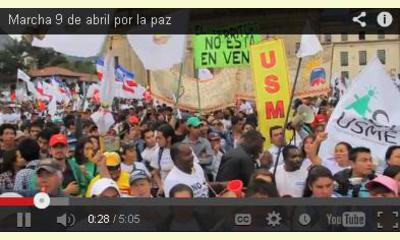|
|
Peace is not stopped by borders (Colombia and Venezuela)
un article par Radio Mundo Real
During the final preparations for the National
Peace Congress to be held in the Colombian capital
next weekend, the meaning and scope of the meeting
both for Colombia and other countries in the
continent is discussed by Edgar Mojica Venegas,
member of the coordinating team for the Congress.

National March for Peace (image from video)
click on photo to enlarge
Mojica was one of the participants of the X
International Meeting of the Network of
Intellectuals, Artists and Social Activists in
Defence of Humanity that will meet in Caracas,
Venezuela, to continue the political legacy of
Hugo Chavez.
In this interview with Radio Mundo Real, Mojica
reflects on what is the starting point for the
discussion of peace in his country from the
perspective of social and humanitarian movements.
"We start from a basic element, trying a couple of
categories to reach a consensus around peace.
Peace for us is a process that goes beyond the
situation and bilateral dialogue. Men and women
have been construcing peace a long time already
and that construction should be respected," said
Mojica.
The National Peace Congress (NPC) is an initiative
of the Congress of the Peoples of Colombia which has
representation from a wide range of social and
political organizations, which shows the scope of
the proposal.
As the second central element in the
conceptualization of the NPC, Mojica said: "Peace
is dynamic and is built from local to regional and
regional to national in an exercise of consensus in
proposals and historical works."
It is also necessary to identify the causes that
gave rise to armed conflict that has continued over
half a century in Colombia if we are to overcome the
conflict through long-neglected structural changes.
Employment, health, housing, use of natural
resources, these are some of the core issues to be
addressed on the way of constructing peace, says
Mojica, who defines the process as "a dialogue of
many voices".
According to Mojica, this requires reversing the
"culture of war" that has sunk its roots in
Colombian society by a "culture of peace", the
consolidation of a social movement for peace.
"The practice of peace building is on the street,
in the social movement," he states. To achieve a
lasting peace with sufficient political force to
overcome the old bilateral logic of "the State
versus the insurgency," he says that we must take
into account that peace in his country has
repercussions throughout the region, especially
since Colombia has become the main focus of U.S.
intervention in South America.
In this regard, here is a video of the National
March for Peace held in Bogotá on April 9, produced
by Contagio Radio.
(Click here for a Spanish version of this article)
|








|
DISCUSSION
Question(s) liée(s) à cet article:
What is happening in Colombia, Is peace possible?
* * * * *
Commentaire le plus récent:
The force of non-violence constrains the force of arms!
Colombia - the force of peaceful resistance -
At the beginning of July, the rebels of the armed revolutionary forces of Colombia (FARC) kidnapped a 51 year old Swiss, and his Colombian assistant who worked in the Indian communities of Cauca province where they were setting up development projects by building schools and community production enterprises.
The news of the kidnapping was spread through all the villages and 2000 Indians set out to pursue the 400 guerillas. They reached them at an elevation of over 4000 meters (12,000 feet), encircled them, and without any weapon, constrained them to release the 2 hostages! (After 2 days, the hostages were released).
This release, obtained through "peaceful resistance" has raised a national debate: the possibility of resisting violence without needing to use weapons has demonstrated the effectiveness of human solidarity movements.
"I will return, and I will then be millions" prophesied the Aymara Indian leader Tapak Katari, in 1781, at the time of his execution by the Spanish conquistadors.
100 million in 1492, the Indians were no more than 4,5 million one century and half later. Currently there are 44 million Indians populating Latin America.
In spite of their great diversity, the Indian movements take on more and more importance. In Ecuador, Guatemala, Bolivia, Peru, Mexico or Colombie they are opposed to the neoliberal system that governs the Americas, while protesting against the imposition of the American economic market. . ... continuation.

|
|









